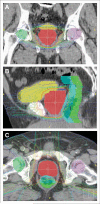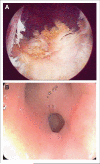Management of complications of prostate cancer treatment
- PMID: 18502900
- PMCID: PMC2900775
- DOI: 10.3322/CA.2008.0002
Management of complications of prostate cancer treatment
Abstract
Prostate cancer is the most commonly diagnosed noncutaneous cancer in men in the United States. Treatment of men with prostate cancer commonly involves surgical, radiation, or hormone therapy. Most men with prostate cancer live for many years after diagnosis and may never suffer morbidity or mortality attributable to prostate cancer. The short-term and long-term adverse consequences of therapy are, therefore, of great importance. Adverse effects of radical prostatectomy include immediate postoperative complications and long-term urinary and sexual complications. External beam or interstitial radiation therapy in men with localized prostate cancer may lead to urinary, gastrointestinal, and sexual complications. Improvements in surgical and radiation techniques have reduced the incidence of many of these complications. Hormone treatment typically consists of androgen deprivation therapy, and consequences of such therapy may include vasomotor flushing, anemia, and bone density loss. Numerous clinical trials have studied the role of bone antiresorptive therapy for prevention of bone density loss and fractures. Other long-term consequences of androgen deprivation therapy may include adverse body composition changes and increased risk of insulin resistance, diabetes, and cardiovascular disease. Ongoing and planned clinical trials will continue to address strategies to prevent treatment-related side effects and improve quality of life for men with prostate cancer.
Figures



References
-
- Jemal A, Siegel R, Ward E, et al. Cancer statistics, 2008. CA Cancer J Clin. 2008;58:71–96. - PubMed
-
- Catalona WJ, Ramos CG, Carvalhal GF. Contemporary results of anatomic radical prostatectomy. CA Cancer J Clin. 1999;49:282–296. - PubMed
-
- Dahl DM, He W, Lazarus R, et al. Pathologic outcome of laparoscopic and open radical prostatectomy. Urology. 2006;68:1253–1256. - PubMed
-
- Eden CG, Cahill D, Vass JA, et al. Laparoscopic radical prostatectomy: the initial UK series. BJU Int. 2002;90:876–882. - PubMed
-
- Han M, Partin AW, Pound CR, et al. Long-term biochemical disease-free and cancer-specific survival following anatomic radical retropubic prostatectomy. The 15-year Johns Hopkins experience. Urol Clin North Am. 2001;28:555–565. - PubMed
Publication types
MeSH terms
Substances
Grants and funding
LinkOut - more resources
Full Text Sources
Medical

